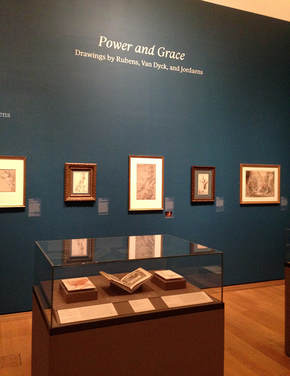 “Power and Grace” at the Morgan Library and Museum is a small exhibition that beings together works on paper by three masters of the Flemish Baroque - - one of art's golden ages. Not only were these three artists contemporaries in Antwerp but they worked together. As seen in their drawings, this relationship clearly influenced their styles. Peter Paul Ruebens was the preeminent artist of his day. Born in Germany, his family moved to Antwerp in the Spanish Netherlands when he was 10 and that city became his base for the rest of his life. The son of a lawyer, his first job at the age of 13 was as a page to a countess but his desire was to become an artist led him to leave this prestigious job. He spent eight years traveling in Italy and Spain studying art. When he returned to Antwerp in 1608, he quickly established himself as a successful artist and was appointed court painter to the archduke and archduchess who governed the Spanish Netherlands on behalf of Spain. In addition to his artistic talent, Rubens was a skilled diplomat. In this role, he traveled extensively in Europe. One such mission took him to England, where he was knighted by King Charles I. He also secured a commission to paint the ceiling of the Banqueting House in London. Thus, he combined diplomacy and art. Rubens developed a large studio. Time did not allow him to do all of the commissions that he received from various royal courts, prosperous merchants and the church. As a result, drawing was very important to him, not only in developing ideas but in order to show his numerous assistants and pupils how he wanted his works completed. Anthony Van Dyck was at one point Rubens' chief assistant. Indeed, the master referred to Van Dyck as the “best of my pupils.” The son or a prosperous silk merchant, Van Dyck was an established painter in his own right by the time he was 15. Like Rubens, Van Dyck went to Italy to study art. Later, probably using recommendations furnished by Rubens, Van Dyck traveled to England. There, he was knighted and became principal painter to Charles I. Commissions poured in from the English court for portraits. Indeed, our image of Engliand's aristocratic society just prior to the English Civil War comes largely from Van Dyck. To handle all of his commissions, Van Dyck maintained a studio of assistants. Following in Rubens' footsteps, Van Dyck used drawings to show his staff his visions. Van Dyck would do a sketch and then it was largely left to the assistant to enlarge it and turn it into a finished painting. How much involvement the master had with each work varied from commission to commission. Like Van Dyck, Jacob Jordaens was born in Antwerp to a prosperous merchant family. Unlike Van Dyck and Rubens, Jordaens did not go to Italy to study art. Indeed, throughout his life, he rarely left Antwerp. Jordeans was nonetheless very influenced by Rubens. At that time, Ruebens was Antwerp's leading artist. On occasion, Rubens would employ Jordeans to enlarge and complete works based upon Rubens' concepts. When Rubens died in 1540, Jordeans became Antwerp's leading painter. (Van Dyck by that time was living in England. Moreover, Van Dyck would die in 1641). The exhibit at the Morgan brings together approximately 30 works on paper from these three masters. Most of the works are from the Morgan's collection but there are some works loaned from other collections. Not surprisingly given the relationship between these three artists, there is a great deal of similarity of style. This is perhaps most evident in three studies of male nudes: Rubens' “Seated Male Youth”; Van Dyck's “Study for the Dead Christ”; and Jordeans' “Study of a Male Nude Seen from Behind “ All are works on colored paper using black chalk heightened by white chalk. In each, the muscles are prominent and handled similarly. There are also examples of preparatory sketches depicting scenes with religious themes. These are interesting for the economy of line that the artists used. Jordeans is the only one who used color but then he began his career using watercolor to create designs for tapestries. All of these artists did portraits but of the three, portraiture is most associated with Van Dyck. Indeed, Van Dyck can be said to have been the primary influence on English portraiture for centuries after his death. The exhibit presents one of his portrait sketches. It is a preparatory sketch for a painting that he did of the wife of a fellow artist and her daughter. Van Dyck took great care and precision with regard to the woman's clothes and jewelry. However, the face again has an economy of line. There is no modeling. Instead, he uses lines to suggest the features and shadows. A second portrait highlights the similarity in styles of these artists. “Portrait of a Young Woman” was for centuries attributed to Rubens. However, in the 1980s, that attribution was questioned and now the expert view is that it is one of the few portraits by Jordeans. Certainly, the use of bold lines and contrast is more similar to Jordeans' works elsewhere in the exhibit; Rubens' works are somewhat more vague. In any case, it is one of the most engaging works in the exhibition. Comments are closed.
|
AuthorRich Wagner is a writer, photographer and artist. Archives
November 2018
Categories
All
|
 RSS Feed
RSS Feed